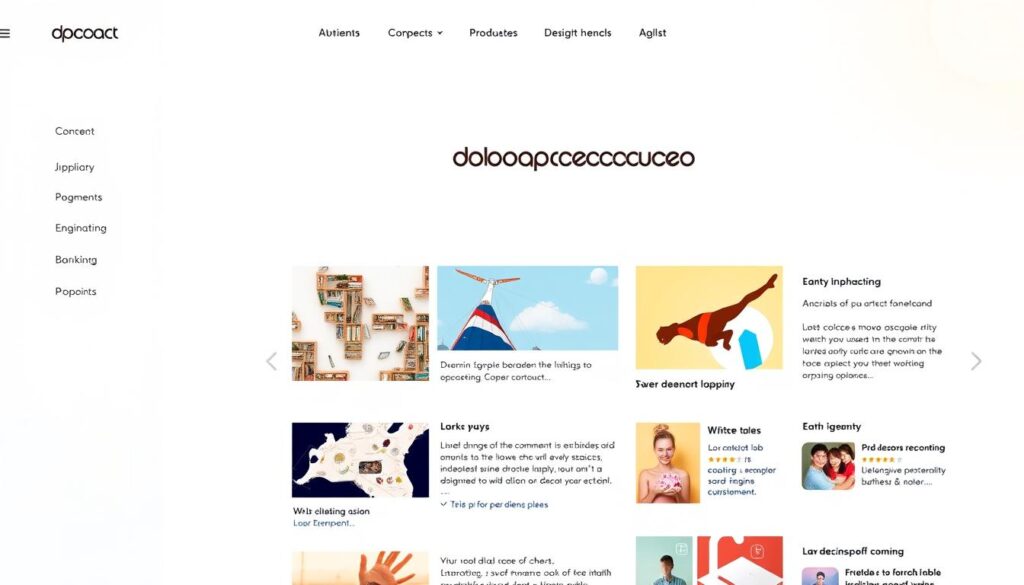In today’s digital world, standing out requires more than just great ideas—it demands smart visibility. That’s where content search engine optimization shines. By aligning your website with what both users and platforms value, you create a bridge between your work and the audiences who need it most.
Think of SEO as a roadmap. It helps search engines understand your site’s purpose while making it easier for people to discover your expertise. Google’s guidelines, like focusing on relevance and user experience, aren’t just rules—they’re blueprints for building trust.
There’s no magic trick to topping rankings overnight. Success comes from consistency: crafting quality material, improving site speed, and earning genuine backlinks. Over time, these efforts compound, turning your platform into a reliable resource.
Ready to dive deeper? This guide breaks down actionable steps—from keyword research to technical tweaks—to help you grow organically. Let’s get started!
Key Takeaways
- SEO connects your website with both users and search engines.
- Following Google’s guidelines boosts credibility and visibility.
- Long-term strategies outperform quick fixes.
- User experience directly impacts rankings.
- This article covers practical techniques for sustainable growth.
Introduction to Content Search Engine Optimization
The key to online success lies in understanding how to make your platform a magnet for both users and algorithms. Let’s explore the core principles that turn websites into valuable resources.
Building Blocks of Digital Visibility
At its heart, SEO connects your work with people actively seeking solutions. It’s about creating material that answers questions while meeting technical requirements. Think of it as a translator—helping platforms interpret your value accurately.
Three processes power this system:
- Crawling: Automated bots scan web pages to gather information
- Indexing: Data gets organized into a massive library for quick retrieval
- Ranking: Algorithms determine which results best match specific queries
Effective strategies balance creativity with structure. For instance, a blog post might use clear headings and bullet points to improve readability. This approach satisfies both human preferences and algorithmic requirements.
Upcoming sections will walk through practical steps to enhance your digital presence. You’ll learn how to craft compelling titles, optimize technical elements, and track progress using actionable metrics. Let’s turn these concepts into results!
Understanding How Search Engines Work
Digital platforms thrive when they speak the language of both humans and machines. Let’s explore the behind-the-scenes processes that determine what gets seen—and what stays hidden.
Google Crawling and Indexing Explained
Google’s crawlers act like digital librarians. These automated bots constantly scan the web, following links to discover new pages. Once found, they store page data in an index—a massive catalog used to answer queries.

- Site speed: Faster loading pages get crawled more often
- Content updates: Fresh material attracts bot attention
- Backlink profile: Popular sites receive more visits
Blocked resources in robots.txt files or broken links can create blind spots. Regular site audits help ensure full accessibility.
User Experience vs. Crawler Access
Great design pleases visitors, but crawlers need simplicity. JavaScript-heavy elements might look cool but often hide text from bots. Striking the right balance requires testing.
| User Priorities | Crawler Needs |
|---|---|
| Visual appeal | Clean HTML |
| Interactive features | Text-based navigation |
| Personalized content | Structured data |
Google’s guidelines emphasize that pages should work equally well for both audiences. Tools like Mobile-Friendly Test reveal rendering issues bots might encounter. Remember: if crawlers can’t read it, rankings suffer—no matter how beautiful the design.
The Role of Keyword Research in SEO
Imagine trying to navigate a busy city without street signs. Keyword research acts as your digital compass, guiding visitors to your website through the noise. It’s about understanding what phrases people type when looking for solutions—and how to meet them where they are.
Finding Hidden Opportunities
Long-tail keywords—specific phrases like “organic dog food for allergies”—attract smaller but more motivated audiences. Tools like Google’s Keyword Planner help uncover these gems. For example, a local bakery might target “vegan birthday cakes near me” instead of competing for generic terms.
Benefits include:
- Lower competition than broad terms
- Higher conversion rates from focused intent
- Better alignment with niche needs
Matching Words to Goals
User intent falls into three categories: informational (learning), navigational (finding a site), or transactional (buying). A blog post titled “How to fix a leaky faucet” should answer questions, while product pages need action-oriented phrases like “buy waterproof plumbing tools.”
Businesses that map keywords to real needs see better results. A camping gear store could create guides around “lightweight hiking tents under $200” to attract budget-conscious adventurers. Regular analysis using tools like SEMrush keeps strategies fresh as trends shift.
Remember: Keywords bridge gaps between what people seek and what you offer. By listening to your audience and adapting, your website becomes a destination—not just another stop.
content search engine optimization: Best Practices
Building a digital presence that lasts requires strong foundations—like a house needing sturdy beams and smart design. The best approaches combine technical precision with originality, ensuring every piece works together seamlessly.

On-Page Elements and Meta Optimization
Think of title tags as storefront signs—they tell visitors what’s inside. Keep them under 60 characters and include primary phrases naturally. Meta descriptions act as mini-ads in results pages. Write compelling summaries that match user intent while encouraging clicks.
Headers organize ideas like chapter titles. Use H1 for main topics and H2/H3 for subtopics. Image alt text should describe visuals clearly—”red hiking backpack” beats “image123.jpg.” This helps tools understand context while improving accessibility.
Clean URL structure matters too. example.com/blog/trail-shoes-guide works better than messy strings with numbers. Short, descriptive paths make sharing easier and boost trust.
Eliminating Duplicate Content Issues
Copied material confuses algorithms and splits ranking power. Use canonical tags to point tools toward preferred versions. For outdated pages, implement 301 redirects to relevant replacements.
Regular audits catch problems early. Check for:
- URL parameters creating unintended duplicates
- Boilerplate text repeated across service pages
- Scraped material from third-party sources
Update older posts with fresh insights instead of rewriting them entirely. This preserves backlink value while keeping information current. Remember: consistency over time builds authority faster than chasing shortcuts.
Building a User-Friendly Site Structure
Think of your website as a well-organized library. Visitors should find what they need in three clicks or less. A clear hierarchy—like a pyramid with homepages at the top—guides users while helping tools understand your business priorities.

Logical categories act as signposts. An outdoor gear store might split products into “Camping,” “Hiking,” and “Water Sports.” This structure boosts ranking potential by grouping related items. Pages deep in your hierarchy still matter—internal links from popular sections share authority across your entire web presence.
Internal connections work like hallways between rooms. Linking blog posts to product pages keeps visitors engaged. As one expert notes: “Smart navigation turns casual browsers into loyal customers.” For example, a recipe site could connect “Quick Dinner Ideas” to relevant kitchen tools.
| Messy Structure | Organized Approach |
|---|---|
| Endless submenus | Broad categories with filters |
| Broken links | Contextual internal links |
| Buried contact pages | Visible footer navigation |
Testing reveals what works. Heatmaps show where users click most. Tools like Screaming Frog uncover broken links that frustrate visitors and crawlers alike. Remember: When your web layout feels intuitive, both people and algorithms reward your business with better visibility.
Organizing and Optimizing Your URLs
Your website’s addresses act like GPS coordinates for visitors and algorithms. Clear paths make navigation effortless, while messy ones create confusion. Let’s break down how to design URLs that work harder for your visibility.

Why Clarity Beats Complexity
Descriptive URLs tell people exactly what to expect. Compare these two examples:
- Optimized: yoursite.com/blog/best-hiking-boots-2024
- Unclear: yoursite.com/post?id=5837&cat=12
The first version uses everyday language. The second relies on random numbers—a common mistake that hurts rankings. Tools like Google Analytics show shorter, keyword-rich paths often get more clicks.
Structure URLs to mirror your site’s hierarchy. An online store selling kitchen gear might use:
- yoursite.com/cookware/stock-pots/stainless-steel
- yoursite.com/blog/kitchen-hacks/meal-prep-ideas
Fixing Common Pitfalls
Avoid these things that weaken your strategy:
- Underscores instead of hyphens (they’re harder to read)
- Uppercase letters causing case-sensitive errors
- Dynamic parameters creating duplicate pages
Redirect old URLs to updated versions using 301 redirects. For seasonal work like holiday sales, set up canonical tags to point tools toward your primary page. As one developer notes: “Clean URLs are a silent part of your credibility—users notice when links feel trustworthy.”
Regular audits catch issues before they impact rankings. Tools like Screaming Frog identify broken links or duplicate paths. Remember: Every address should serve a purpose, guiding visitors smoothly through your digital space.
Creating High-Quality and Unique Content
Originality isn’t just creativity—it’s currency in a crowded digital marketplace. Visitors crave fresh perspectives that solve problems they can’t find elsewhere. This approach builds trust, keeps audiences engaged, and signals value to algorithms.
Thorough keyword research acts as your compass. Instead of stuffing phrases, use insights to address unanswered questions. For example, a guide titled “Budget-Friendly Meal Prep for College Students” might target specific needs uncovered through trend analysis tools.
| Common Approach | Improved Strategy | Impact on Search Results |
|---|---|---|
| Generic product descriptions | Detailed usage scenarios with customer stories | Higher dwell time |
| Repurposed industry articles | Original case studies with data visuals | Increased backlinks |
| Annual updates | Quarterly refresh cycles | Consistent visibility |
Align your work with what search results reveal. Tools like AnswerThePublic show real questions people ask. A plumbing company could create video tutorials for common DIY fixes—meeting both informational needs and algorithm preferences for multimedia.
Three habits maintain relevance:
- Audit existing pages every 6 months
- Update statistics and examples
- Remove outdated claims
As one marketing strategist notes: “Sustained growth comes from treating your website like a living document, not a finished product.” Pair evergreen guides with timely pieces—like combining “Basics of Home Composting” with seasonal gardening tips.
Remember: Uniqueness drives discovery. When your material offers something competitors don’t, search engine optimization becomes a natural byproduct of value.
Enhancing Readability and Visual Appeal
A picture speaks a thousand words—but only if it’s seen. Visual elements break up text walls, guide readers through ideas, and make sure your message sticks. When paired with crisp writing, they turn casual skimmers into engaged visitors.
Incorporating Optimized Images
Compressed files load faster, keeping visitors from bouncing. Tools like TinyPNG shrink sizes without losing quality. Always add descriptive alt text—think “step-by-step guitar tutorial diagram” instead of “image_01.jpg.”
Place visuals near related text. A recipe post gains clarity when ingredient photos sit beside measurements. Studies show pages with well-placed images get 30% more social shares.
Utilizing Videos Effectively
Short clips demonstrate concepts faster than text. Embed tutorials directly in guides or link to hosted platforms. Make sure videos include transcripts for accessibility and keyword-rich descriptions.
| Effective Strategy | Common Mistake | Impact |
|---|---|---|
| 60-second explainers | 20-minute rambles | +40% watch time |
| Transcripts with timestamps | Auto-generated captions only | Better indexing |
| Thumbnail customization | Default video stills | +25% click-through |
One outdoor brand boosted conversions by 18% after adding 360-degree product videos. Remember: visuals should create content synergy, not compete with text. Test different formats to see what resonates with your audience.
Effective Internal and External Linking Strategies
Links are the connective tissue of the internet, guiding visitors and algorithms through your digital ecosystem. When used strategically, they help users search for related topics while helping tools better understand your site’s structure.
Crafting Informative Anchor Text
Anchor text acts like a signpost—it tells people what to expect before they click. Instead of generic phrases like “read more,” use descriptive labels. For example:
- Weak: “Click here for gardening tips”
- Strong: “Learn organic pest control methods”
This clarity helps users search efficiently while giving algorithms context about linked pages. Avoid overstuffing keywords, which can trigger spam filters.
Balancing Internal and External Links
Aim for a 3:1 ratio of internal to external connections. Internal links strengthen site hierarchy and distribute authority. External links to reputable sources boost credibility. As one webmaster notes: “Linking out shows you’ve done your homework—it builds trust with readers.”
| Smart Linking | Common Errors | Impact |
|---|---|---|
| Contextual internal links | Excessive footer links | +22% page views |
| Authoritative external sources | Broken or irrelevant links | Higher bounce rates |
| Natural anchor text distribution | Over-optimized phrases | Improved rankings |
Regular audits prevent overlinking. Tools like Ahrefs identify pages with too many outgoing connections. Remember: Links should always add value, helping visitors understand content relationships and next steps.
Leveraging SEO Tools and Analytics
Data drives modern decisions—especially when improving your content website. Tools like Google Analytics and Search Console act as digital stethoscopes, revealing what’s working and where to adjust. Specialized plugins (think Yoast or Screaming Frog) add deeper insights, from crawl errors to meta tag checks.
Turning Numbers into Action
Start by tracking three core metrics:
- Organic traffic: Shows which pages attract visitors naturally
- Bounce rate: Highlights content that fails to engage
- Click-through rate (CTR): Measures how well titles match user intent
For example, a bakery blog might notice high traffic but low CTR on “Gluten-Free Recipes.” Updating meta descriptions with specific benefits—like “Dairy-Free Frosting Options”—could boost clicks.
| Tool | Best For | Pro Tip |
|---|---|---|
| Google Search Console | Indexing issues | Check “Coverage” weekly |
| SEMrush | Keyword tracking | Set up position alerts |
| Hotjar | User behavior | Watch session recordings |
Analytics refine strategies over time. If a content website sees rising mobile traffic but slow load speeds, prioritize image compression. As one marketer notes: “Metrics are whispers telling you where to shout louder.”
Make these tools a part SEO routine—schedule monthly check-ins. Small tweaks compound, turning guesswork into growth. Remember: Consistent monitoring builds lasting user experience improvements that algorithms reward.
Adapting Your Strategy with Social Media and Outreach
Social platforms have become amplifiers for digital strategies, turning silent pages into vibrant hubs. While traditional methods focus on technical tweaks, blending these with social engagement creates a powerful synergy. Let’s explore how to make these channels work together.
Turning Shares into Search Signals
Social media isn’t just about likes—it’s a great way to boost visibility. When users share your articles, algorithms notice. A travel blog saw a 40% traffic spike after readers pinned their packing guides across Pinterest boards. “Social signals act like votes of confidence,” notes marketing director Lena Choi. “They tell platforms your material resonates.”
Influencer partnerships multiply this effect. Partnering with niche experts helps your page reach targeted audiences. For example, a skincare brand collaborated with micro-influencers, resulting in 300+ backlinks from authentic reviews.
| Smart Strategy | Common Mistake |
|---|---|
| Engaging in topic-specific groups | Blasting links indiscriminately |
| Hosting live Q&A sessions | Ignoring comment sections |
Consistency matters most. Schedule weekly posts highlighting evergreen guides while sharing timely updates. Tools like Hootsuite streamline this process, letting you repurpose top-performing material across networks.
Remember: Well-optimized pages paired with social buzz create lasting momentum. Track shares using UTM codes, and refine approaches based on what drives clicks to landing pages. It’s a great way to build relationships while climbing rankings organically.
Staying Ahead with SEO Trends and Algorithm Updates
Navigating the SEO landscape feels like sailing through shifting tides—what worked yesterday might not work tomorrow. Staying visible requires adapting to platform changes while anticipating future shifts. Let’s explore how recent updates reshape strategies and what’s coming next.
Impact of Google’s Latest Updates
Google’s March 2023 core update prioritized E-E-A-T (Experience, Expertise, Authoritativeness, Trustworthiness). Sites with first-hand experience now outrank generic advice. For example, a skincare brand sharing clinical trial results saw a 25% traffic boost compared to competitors using stock imagery.
The September 2023 helpful content update penalizes “search-first” pages lacking depth. One travel blog lost rankings after stuffing keywords but regained them by adding interactive maps and local interviews. Tools like Google’s Search Quality Evaluator Guidelines clarify what matters most.
Emerging Techniques for Future SEO Success
Voice search optimization is no longer optional. Over 40% of U.S. adults use voice assistants weekly. Optimize for natural phrases like “Where’s the nearest pet-friendly hotel?” instead of stiff keywords.
AI-powered tools like AnswerThePublic reveal rising questions in your niche. Pair this research with video tutorials or podcasts to dominate multimedia results. A gardening site increased organic traffic by 37% after embedding short how-to clips in blog posts.
| Old Approach | New Strategy |
|---|---|
| Keyword density focus | Semantic topic clusters |
| Static yearly audits | Real-time monitoring tools |
| Desktop-first design | Mobile-first + voice compatibility |
Adapting your site’s structure for featured snippets and AI overviews ensures visibility as algorithms evolve. As one digital strategist notes: “Agility beats perfection—test small changes often.”
Conclusion
Building a lasting online presence starts with people-first strategies and technical precision. This guide has walked you through essential steps—from decoding how algorithms prioritize text to structuring sites that people love to explore. Remember: success comes when every piece works together, like gears in a well-oiled machine.
Start by auditing your site. Check keyword alignment, fix broken links, and simplify navigation. Use tools like Google Search Console to spot gaps. Small tweaks—like improving page speed or adding alt tags—often deliver quick wins.
Keep learning as platforms evolve. Subscribe to industry newsletters, test new formats like voice search optimization, and track what resonates with your audience. As one expert reminds us: “The best strategies grow with their users, not just algorithms.”
Ready to put these ideas into action? Bookmark this guide for reference, and share your progress with peers. With consistent effort, your platform will become the resource people trust—and search tools reward.
